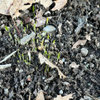Not sure I'm looking forward to spring any more... !
ctlady_gw
15 years ago
Related Stories

WINTER GARDENING6 Reasons I’m Not Looking Forward to Spring
Not kicking up your heels anticipating rushes of spring color and garden catalogs? You’re not alone
Full Story
BATHROOM COLORSpring Forward With a Green Bathroom
Use nature’s freshest hues to make your space really sing
Full Story
PRODUCT PICKSGuest Picks: Design-Forward Outdoor Furniture
Treat yourself to one of these splurge-worthy patio pieces and enjoy great outdoor style for many summers to come
Full Story
DECORATING GUIDESHot Looks From the Spring 2013 High Point Market
Get an eyeful of some of the colors, textures, materials and more taking a big stand at North Carolina's huge furnishings trade show
Full Story
LANDSCAPE DESIGNHow to Look Good From Any Angle (the Garden Edition)
Does your garden pique interest from one vista but fall flat from another? These tips and case-study landscapes can help
Full Story
HOUZZ TOURSHouzz Tour: Visit a Forward Thinking Family Complex
Four planned structures on a double lot smartly make room for the whole family or future renters
Full Story
WINDOWSSteel-Framed Windows Leap Forward Into Modern Designs
With a mild-mannered profile but super strength, steel-framed windows are champions of design freedom
Full Story
COLORYou Said It: ‘Adding Color Is About So Much More Than Shock’ and More
Highlights from the week include color advice, Houzzers helping Houzzers and architecture students building community housing
Full Story
GREEN BUILDINGLook to the Sun for More of Your Home's Lighting
Manage sunlight with design-savvy windows, solar tubes and skylights to save energy and show your home's beauty
Full Story
EVENTSSee Frank Lloyd Wright Treasures and More at This Spring House Walk
Celebrate the birth of modern architecture with a spring tour of Chicago-area Frank Lloyd Wright homes this May
Full Story




runktrun
ginny12
Related Discussions
Looking forward to SPRING FLUSH!
Q
Please look at our kitchen plan, I'm not sure about it...
Q
I'm 99% sure this is a weed, any small chance it's a shrub?
Q
I'm sure half and half will not look good!
Q
ctlady_gwOriginal Author
runktrun
spedigrees z4VT
ctlady_gwOriginal Author
spedigrees z4VT
ctlady_gwOriginal Author
diggerdee zone 6 CT
Nancy Vargas Registered Architect
sedum37
Thyme2dig NH Zone 5
evonnestoryteller
Marie Tulin
newhamsha
ctlady_gwOriginal Author
newhamsha
spedigrees z4VT
ctlady_gwOriginal Author
spedigrees z4VT
newhamsha
NHBabs z4b-5a NH
User
aeiger
pondlily
diggingthedirt
ctlady_gwOriginal Author
spedigrees z4VT
diggingthedirt
claireplymouth z6b coastal MA
Thyme2dig NH Zone 5
ctlady_gwOriginal Author
hunt4carl
diggingthedirt
eandhl
lise_b
dfaustclancy
diggingthedirt
WendyB 5A/MA
NHBabs z4b-5a NH
WendyB 5A/MA
kendra5